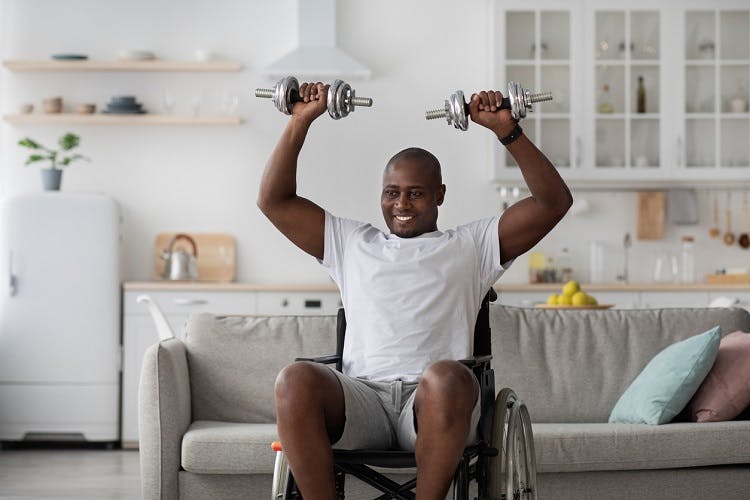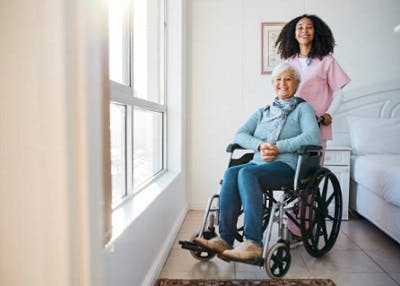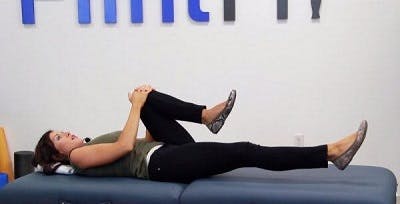No products in the cart.
No products in the cart.
No products in the cart.
No products in the cart.
Home » Neurological Recovery Blog » Spinal Cord Injury » Spinal Cord Injury Exercises: Improving Mobility After SCI
Last updated on May 10, 2022

When a spinal cord injury disrupts the transmission of signals between the brain and body, completing spinal cord injury exercises can often help restore this communication. Rehab exercises are essential for activating neuroplasticity, which is the central nervous system’s ability to rewire itself and strengthen neural pathways.
When searching for spinal cord injury exercises to add to your home therapy regimen, it’s essential to find exercises most suitable to your level of ability. This article will discuss the benefits of spinal cord injury exercises and the various types you can use to promote recovery. Be sure to check with your therapist to make sure the exercises are safe for you.
Before diving in, let’s first go over the mechanisms behind spinal cord injury recovery.

Every spinal cord injury is different, and the effects survivors may experience also vary. The amount that sensation and muscle movement are affected following a spinal cord injury depends mostly on the level of injury and its severity. The spinal cord is capable of rewiring itself and adapting through the process of neuroplasticity, as long as some connections in the spinal cord remain intact (the injury is not complete).
Neuroplasticity allows existing spared neural pathways in survivors with an incomplete SCI to become stronger and learn new functions. Thus, the more spared neural pathways, the higher the chances of recovery. Of note, although affected functions do not improve with traditional treatments in those with complete spinal cord injuries, some functional recovery using compensatory strategies can still be achieved.
Neuroplasticity is best activated through high repetition exercises, or massed practice. Consistent repetition of weakened movements and stimulation of areas with affected sensation helps to stimulate the spinal cord and promote neurological adaptations. Spinal cord injury exercises also focus on improving mobility by stretching tight muscles, strengthening weakened muscles, and moving the joints through full range of motion.
For instance, survivors may experience spasticity after spinal cord injury, which causes the muscles to tighten up. To help reduce spasticity, individuals can stretch and practice range of motion exercises.
Range of motion exercises are also beneficial for improving blood flow and reducing the risk of pressure sores even if your spinal cord injury is complete. Furthermore, the more you engage in spinal cord injury exercises, the greater your chances of improving mobility.
Spinal cord injury exercises are undoubtedly beneficial, but now you may be wondering, what type of exercises should you practice?
While every spinal cord injury has different functional outcomes, most spinal cord injury survivors can practice passive range of motion exercises.
Passive range of motion exercises do not require the survivor to exert a lot of energy. Instead, a therapist or caregiver moves the survivor’s body for them. Individuals who have more control of their movements should try to actively perform range of motion exercises on their own as much as they can.
Passive range of motion exercises challenge you to move your joints through their full range of motion. This helps prevent stiffness and promote circulation in the paralyzed or weakened areas of the body. Try practicing passive range of motion exercises at least once daily to minimize tightness in the joints and stimulate the nervous system.
Here is a video with examples of various SCI passive range of motion exercises you can try with a therapist and/or caregiver. Be mindful of doing these exercises on your own if you are still building up strength to avoid overworking yourself.
Begin with your arm relaxed at your side. Have a therapist or trained caregiver raise your arm out in front of you, reaching as high as possible without pain. Try to keep your shoulder from shrugging upward and keep the rest of your body aligned. Then your therapist or caregiver can support your arm as it comes back down to your side, and repeat.
Starting with your arm relaxed and your hand facing your side, have a therapist or trained caregiver gently bend your elbow, rotating your forearm so your hand turns toward your shoulder. Bend your elbow as much as possible without pain. Then relax your arm and repeat. This exercise also includes elbow extension, supination, and pronation.
While sitting, have a therapist or trained caregiver slowly move your leg upwards until your knee is nearly straight. Gently bring your legs back down into your starting position, and repeat. If you are able to actively help with this motion, you should feel the muscles on the front of your thighs engage when doing this exercise.
Starting in a seated or laying position, have a therapist or trained caregiver raise your toes up toward your calf, then relax back to a neutral position. Again, stop if you feel any pain.
As you begin to recover, try to move through these motions with less help from your therapist or caregiver. If you improve and are able complete these exercises actively but tire quickly, take a break or ask your therapist or caregiver to take over for the remainder of the range of motion exercises. Your endurance should also improve over time with more consistent practice.
There are various exercises you can do to strengthen the muscles in your legs and improve mobility. Additionally, SCI leg exercises help reduce muscle atrophy, improve circulation, and stimulate adaptive changes in the spinal cord.
However, before engaging in leg exercises for SCI it’s important to warm up and stretch. The following video demonstrates various leg stretches you can try using a strap, resistance band, or large towel.
Spinal cord injury can also affect the ability to feel, therefore survivors need to be extra careful and pull gently when stretching to avoid injury.
Once you’re warmed up, try these helpful leg exercises for spinal cord injury:
While also laying down, you can point your toes down so that the ankle is extended. Then raise your feet upwards towards the knees to flex the ankles. This exercise mimics the motions the ankles create when walking.

Place one hand on the upper leg just above your knee and the opposite foot. Bend one knee in so that it’s reaching towards your chest. Then bring your foot down and straighten the knee.
Lay down with your legs straightened and lift one leg without bending at the knees. When the leg is as high as it can go, hold for a few seconds. Bring the leg back down and alternate with the other leg. Try to engage your core while doing this exercise to avoid putting undue stress on the lower back.

Sit at the edge of your seat with both feet on the ground, then alternate lifting your knees one at a time. This leg exercise allows survivors to practice movements used while walking without added pressure on their joints.
Discover more leg exercises for spinal cord injury patients »
Spinal cord injury survivors with cervical or high thoracic level injuries may often experience weakness in the hands. Fortunately, various hand and arm exercises can help improve fine motor skills and reduce weakness after spinal cord injury.
Here are some upper extremity spinal cord injury exercises you can try:
For this exercise, put your arms out to the side so that your body makes a “T” shape. Then move your arms in a circular motion going forward and backward. You can alternate between making large circular motions or smaller ones.

Using one or both hands, alternate tapping the tips of each finger to the thumb. After touching each finger, you can also add closing the hand into a fist. Hold a few seconds or as long as you can and straighten the fingers back out.
Hold one arm out in front of you with your palm facing down. Then use your other hand to grab the palm and pull it back up.
Lay your hand flat on a tabletop or wall. Then practice spreading the fingers apart and bringing them back together.

While these hand therapy exercises may seem simple, they are extremely effective. However, practicing the same movements can get boring and cause you to lose motivation. To help keep you motivated and engaged you can use gamified neurorehabilitation devices.
For example, MusicGlove is a hand therapy device that combines music, gaming, and hand therapy exercises to help you stay engaged and practice high repetitions from the comfort of your own home. MusicGlove has been clinically proven to boost hand function in just 2 weeks!
Discover more hand therapy exercises for spinal cord injury patients »
Core exercises after spinal cord injury are also essential because they help stabilize the trunk for better balance and posture.
The following video will guide you through some wheelchair-friendly exercises to strengthen the core. Before practicing these exercises, always check that the brakes on your wheelchair are set.
Speak with your therapist before engaging in some of these core exercises if you still have spinal precautions, or have certain movements that need to be avoided after your SCI.
Sit at the edge of the seat and lean back against the chair. Hold for a few seconds or as long as you can and use your core muscles to sit up straight again.
While sitting in a chair, slowly lean forward as far as you comfortably can and try reaching your hands to the floor. Then, use your back muscles to slowly sit back up. If you have trouble with your sitting balance, be sure to have someone nearby to spot you during this exercise.
Start by laying down and keep your knees bent and feet flat on the floor. Try to keep your shoulders and upper body firmly on the floor. Tighten the abdominal muscles and relax the knees down toward the floor on one side of your body, then the other.
Discover more core strengthening exercises for spinal cord injury patients»
The best way to improve mobility after SCI is to consistently practice spinal cord injury exercises. This helps stimulate neuroplasticity in undamaged regions of the spinal cord and strengthen the pathways that control movement.
Every spinal cord injury is different and every survivor will have different functional outcomes so try not to feel discouraged if an exercise is too difficult. A therapist can help you adjust and provide SCI exercises for your level of mobility.
We hope this article has inspired you to engage in spinal cord injury exercises to promote recovery.

Get instant access to our free exercise ebook for SCI survivors. If you liked this post, you’ll LOVE our emails and ebook.
Each exercise features pictures of a licensed therapist to help guide you. You’ll also receive our popular recovery emails with SCI survivor stories and other useful tips — you can opt out anytime.
We will never sell your email address, and we never spam.


Flint Rehab is the leading global provider of gamified neurorehab tools. Check out our bestselling tool by clicking the button below:
Depending on the severity of your spinal cord injury, there may be hope for improved mobility. Consistent at-home therapy is key to making this happen.
That’s why Flint Rehab created FitMi, a motion-sensing, gamified home recovery tool designed for neurological injury like SCI.
Here’s what others have said about it:
“I purchased this wonderful equipment for the use of spasticity for my right hand. Initially I wasn’t sure if it would work because of the various treatments I tried and also many physiotherapists who tried their level best, but didn’t achieve any positive results.
However after trying FitMi, I could feel that slowly and steadily I am improving. It’s really a great device that minutely takes care of each and every muscle of your affected body part. The biggest plus point is, you can use this device anywhere, anytime with precise exercises that you need and also saves your money and time spent on your physiotherapist.“
— Chandrakiran
FitMi works by encouraging you to practice rehab exercises with high repetition. On average, survivors complete hundreds of repetitions per half hour session.
“Massed practice” like this helps stimulate and rewire the nervous system. While you can achieve massed practice with a written sheet of exercises, it can be tough to stick with it consistently — and consistency is key to recovery.
FitMi helps transform rehab exercises into an engaging, interactive experience. The yellow and blue “pucks” track your movement and provide feedback. All of this comes together for a motivating home therapy program.
A survivor named Tom put it perfectly:
“I believe this device will help me concentrate on making the repetitive actions needed to obtain further movement range in my wrist and hand and arm and therefore rating it with five stars. My occupational therapist recommended to give this a try. I have been using FitMi for just a few weeks. I feel more at ease in flexing.”
If you’d like to learn more about FitMi, click the button below:

Do you have this 15 pages PDF of SCI rehab exercises?
Get a free copy of our ebook Rehab Exercises for Spinal Cord Injury Recovery. Click here to get instant access.
Grab a free rehab exercise ebook!
Sign up to receive a free PDF ebook with recovery exercises for stroke, traumatic brain injury, or spinal cord injury below: